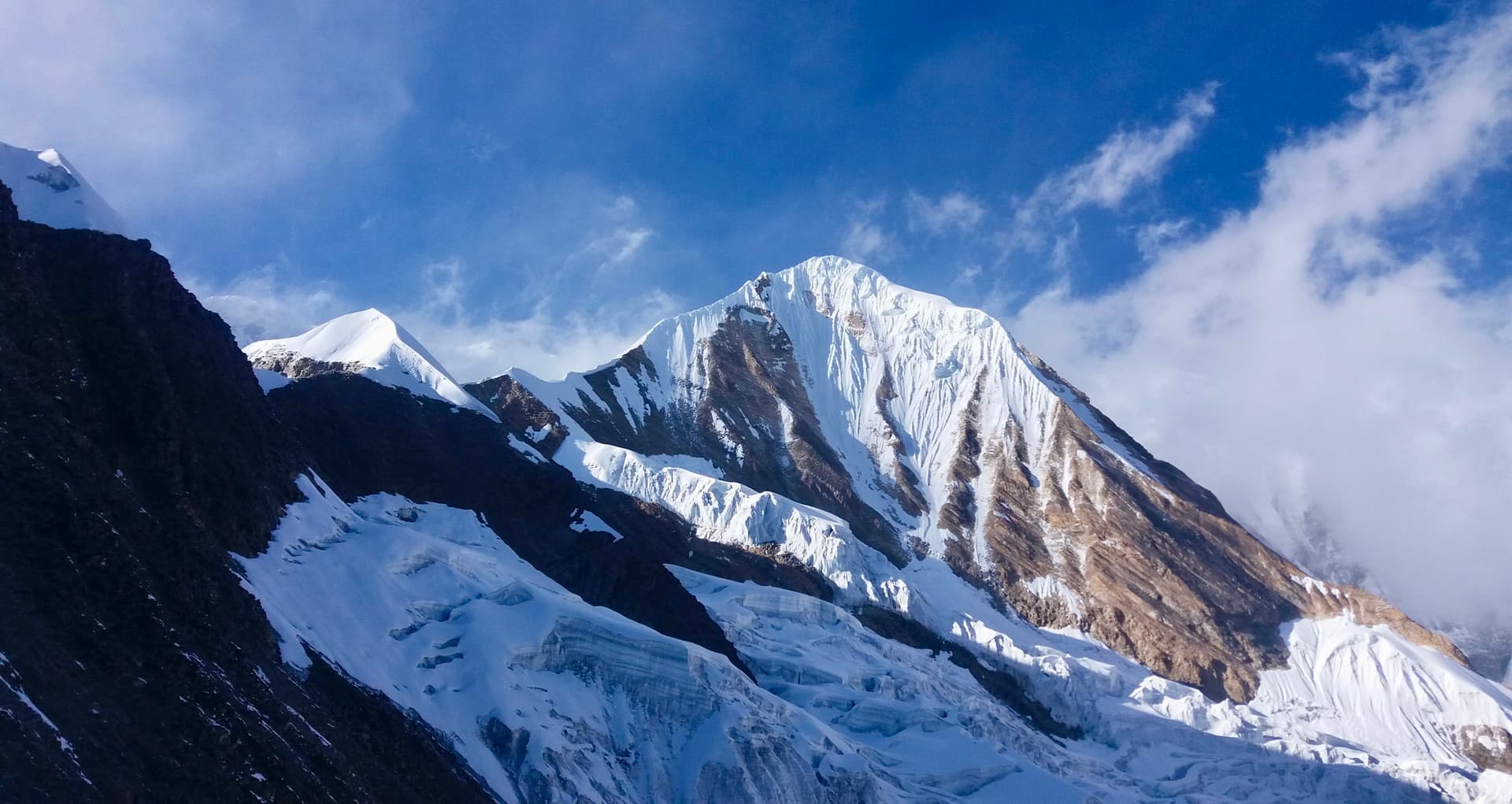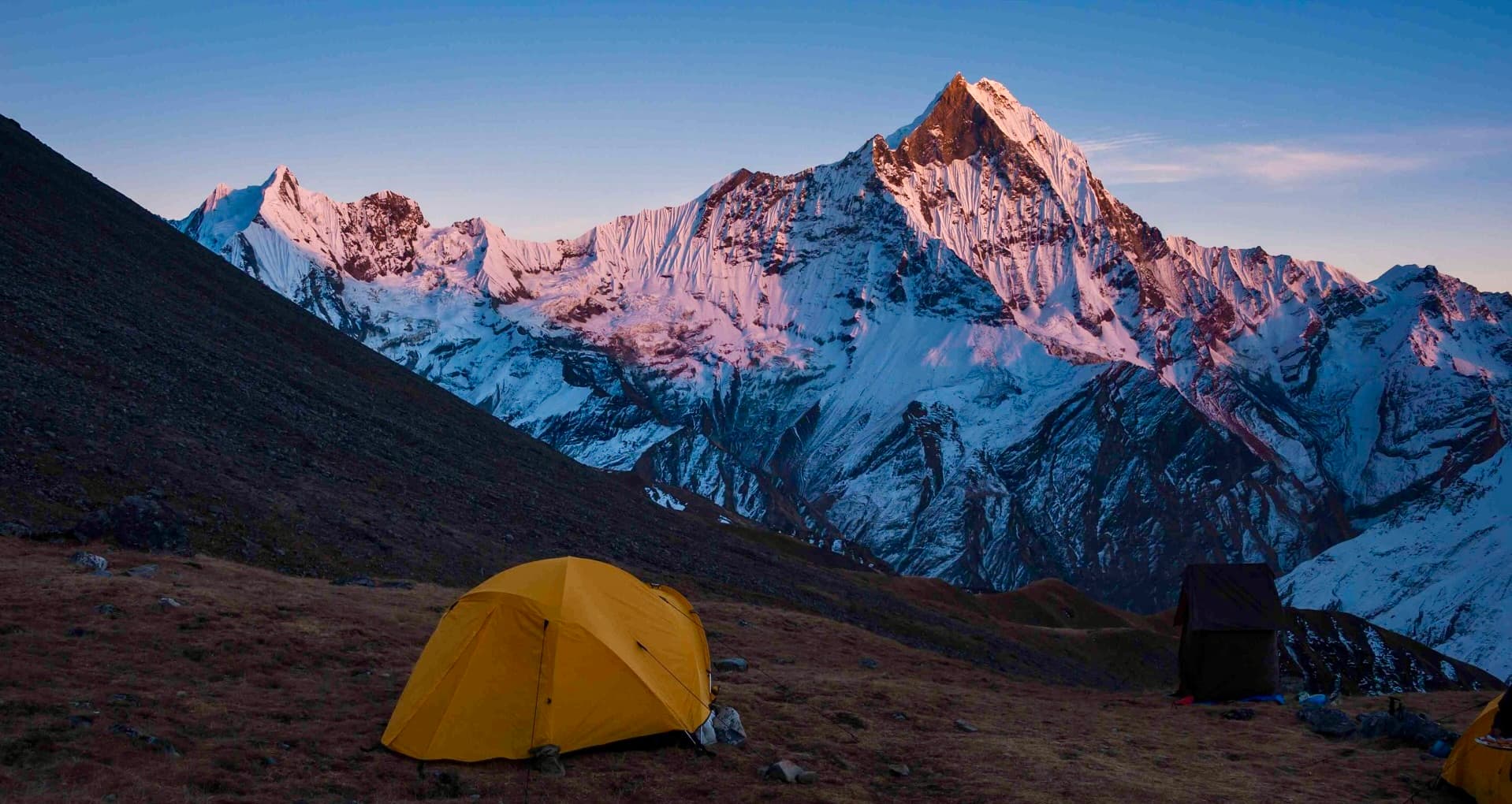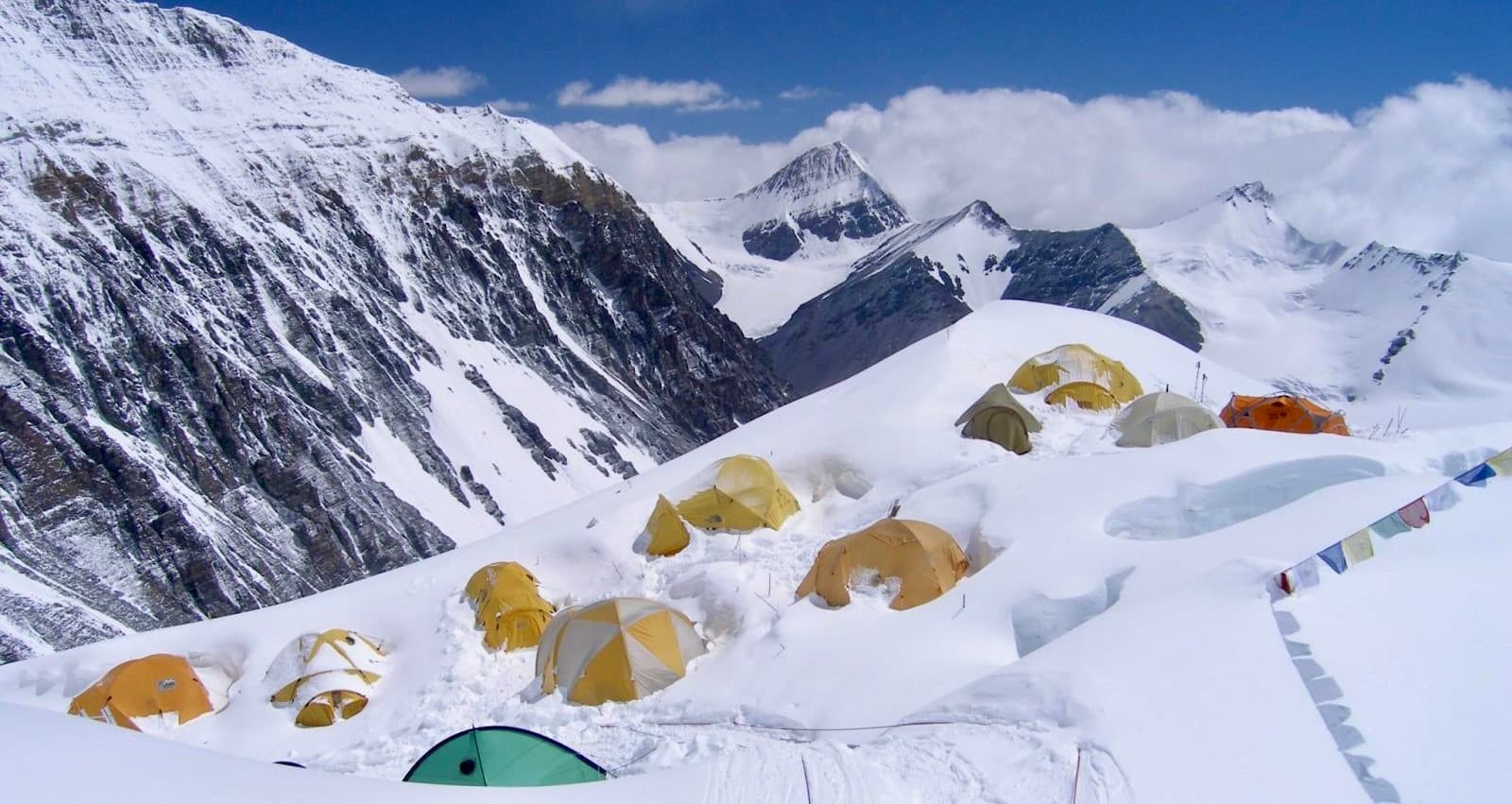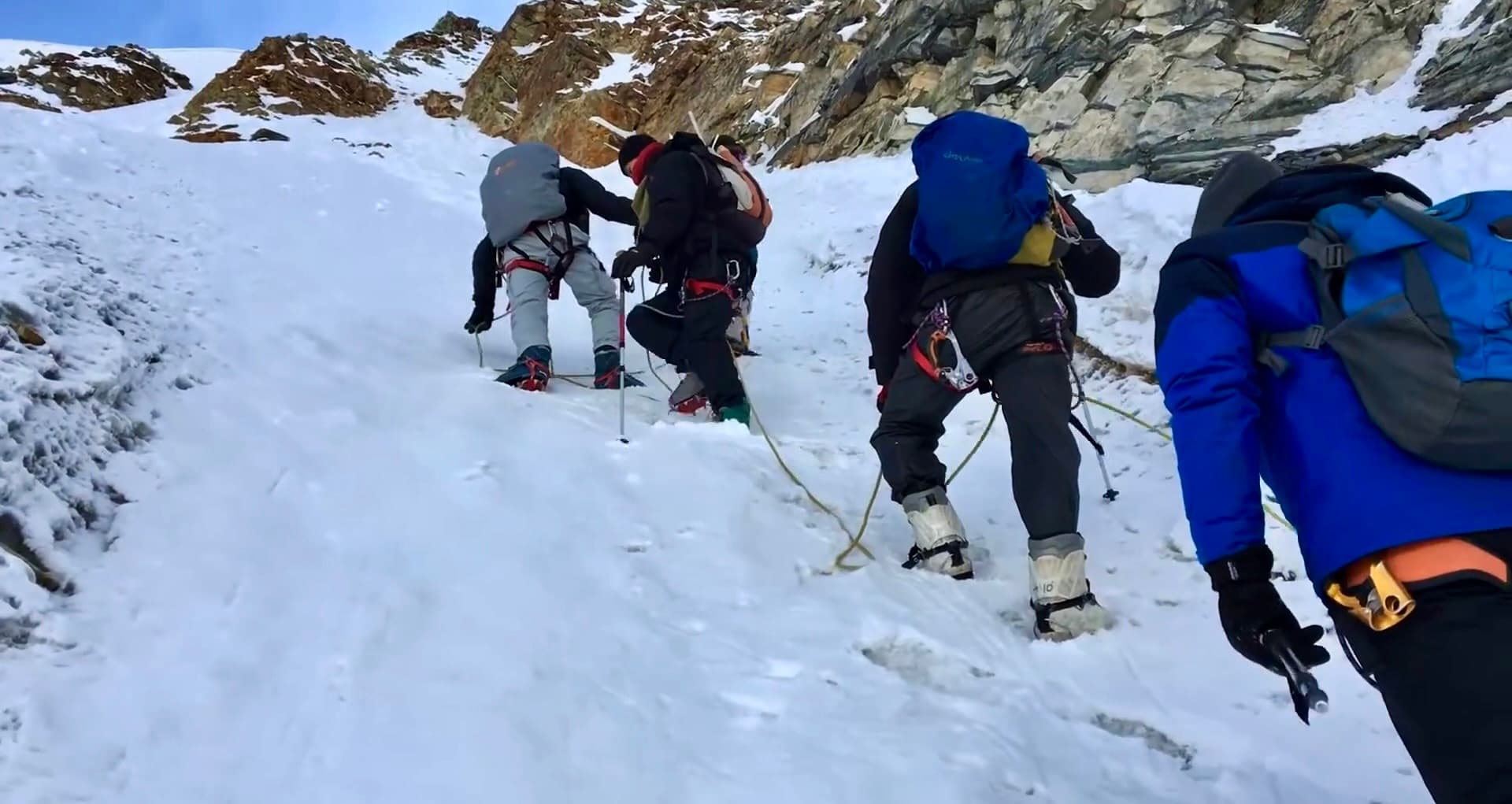Singu Chuli, commonly known as Fluted Peak, is a trekking peak in Nepal that rises to a height of 6,501 meters and is situated in the Annapurna Conservation Area. Due to the steep ascent required to reach the summit, Singu Chuli is regarded as one of the most technical summits. It is one of the most well-known summits since it is close to Annapurna, the tenth-highest mountain in the world, whose base camp is encircled by breathtaking mountains in a natural amphitheater.
Singu Chuli Peak Climbing is for those who are wanting to level up their technical skills in mountaineering and dream of achieving summits of higher elevations. There is this technical section of Singu Chuli Climb which is a bit difficult and needs some expertise to cross it. It is a vertical wall very near the summit point and only people with alpine and ice climbing experience can be good in this part. So yeah, the peak expedition is definitely not easy but one thing that you’ll get for sure is the required experience for the next climbs. beautiful happenings of the trek which includes abundant mountain displays, and scenic terrain.
With Luxury Holiday Nepal by your side, you're not just embarking on another expedition; you're embracing an adventure that promises unparalleled vistas, unwavering support, and an achievement that will echo for a lifetime.
Highlights of the Singu Chuli Peak Climbing
- Majestic Vistas: From the base to the pinnacle, enjoy a panoramic view of iconic peaks including Annapurna, Machhapuchhre, and Dhaulagiri, which make up the mesmerizing Annapurna Massif.
- Technical Challenge: The climb offers a true mountaineering experience, testing your technical skills, especially when confronting the notorious vertical wall near the summit.
- Annapurna Base Camp: Experience the surreal beauty of the Annapurna Base Camp, a natural amphitheater surrounded by towering peaks.
- Trek through Diverse Terrains: From lush rhododendron forests in Ghorepani to alpine meadows and glacial moraines, the journey is as diverse as it is breathtaking.
- Sunrise from Poon Hill: Witness a golden sunrise over the Annapurna range, a sight that has been a muse for countless travelers and artists alike.
- Hot Springs at Jhinu Danda: After days of rigorous climbing, immerse in the therapeutic waters of Jhinu Danda, nature's very own spa.
- Rich Cultural Insights: Engage with the warm and welcoming Gurung and Magar communities. Delve deep into their traditions, folklore, and Himalayan lifestyle.
- Acclimatization Days: Enjoy the meticulous planning that ensures your safety with acclimatization days, giving your body the time it needs to adjust to higher altitudes.
- Flora and Fauna: Journey through the Annapurna Conservation Area, home to diverse species of plants, birds, and animals. Keep an eye out for the vibrant rhododendron, the national flower of Nepal, especially during spring.
Join Luxury Holiday Nepal on this adventurous expedition and make memories that will be etched in your heart forever. Whether you are a seasoned mountaineer or an ardent trekker looking to push your boundaries, Singu Chuli awaits to mesmerize and challenge you.
Features of Singu Chuli Peak Climbing
Singu Chuli Peak Climbing, also known as Fluted Peak, offers several notable features and challenges that make it an exciting adventure for experienced climbers. Here are some key features of Singu Chuli Peak Climbing:
Altitude and Geography of Singu Chuli
Tucked within the spectacular landscapes of the Annapurna Conservation Area, Singu Chuli stands majestically at a height of 6,501 meters. Often referred to as the Fluted Peak, Singu Chuli offers more than just its altitude; it provides an invitation to mountaineers seeking technical challenges and unparalleled beauty.
The Altitude:
Reaching an elevation of 6,501 meters, Singu Chuli is amongst the higher trekking peaks of Nepal. This imposing altitude requires climbers to be vigilant about proper acclimatization, given the inherent risks associated with high-altitude trekking and climbing. The significant elevation gain as one progresses on the climb underscores the importance of a well-paced ascent.
The Geography:
-
Location: Singu Chuli is strategically positioned in the heart of the Annapurna Conservation Area, a protected region that boasts of some of the most iconic peaks, diverse flora and fauna, and captivating landscapes.
-
Physical Features: The peak presents a unique combination of challenging ridges and intricate icy sections. Its name, the Fluted Peak, is derived from the fluted ice walls and ridges that characterize its upper sections. These features pose technical challenges, making the climb a rigorous endeavor even for seasoned mountaineers.
-
Proximity to Other Peaks: Singu Chuli's location ensures that climbers are treated to panoramic views of its towering neighbors, including the mighty Annapurna and the mesmerizing Machhapuchhre.
-
Terrain: The routes leading to the base camp of Singu Chuli traverse through varied terrains – from dense forests harboring rhododendrons and oaks to alpine meadows and glacial moraines. As climbers ascend further, the lush greenery gives way to snow-clad landscapes and glaciated terrains, a testament to the peak's diverse geography.
Singu Chuli is not just about its imposing altitude; it's about the geographically rich and diverse environment it offers to every climber. The blend of altitude and intricate geography makes the Singu Chuli expedition an unforgettable experience, drawing mountaineers from across the globe to embrace its challenges and revel in its beauty.
Technical Difficulty
Singu Chuli Peak Climbing is known for its technical difficulty, making it suitable for experienced climbers with advanced mountaineering skills. Here are some specific technical challenges associated with Singu Chuli Peak:
- Steep Ascents: Singu Chuli involves steep ascents, particularly during the climb to the High Camp and the final push to the summit. Climbers must be comfortable and skilled in ascending steep terrain while carrying climbing gear and maintaining balance.
- Vertical Walls: One of the notable technical sections of Singu Chuli is a vertical wall located near the summit. Climbers need alpine and ice climbing experience to navigate this section, which requires proper use of climbing equipment such as ropes, ice axes, and crampons.
- Glacier Crossing: The climb may involve crossing glaciers or sections of icy terrain. Climbers must have knowledge and experience in glacier travel techniques, including rope management, crevasse rescue, and route finding on icy surfaces.
- Snow and Ice Conditions: Singu Chuli's technical difficulty is heightened by varying snow and ice conditions. Climbers should be proficient in using crampons and ice axes, as well as have the ability to assess the stability and safety of snow and ice before proceeding.
- Route Finding: Singu Chuli Peak may require route finding skills, especially in sections with complex and changing terrain. Climbers must be able to navigate through challenging and unfamiliar landscapes, often relying on their experience, maps, and GPS devices.
- Altitude and Acclimatization: The high altitude of Singu Chuli adds to its technical difficulty. Climbers must be prepared to face the effects of altitude, including decreased oxygen levels and the risk of altitude sickness. Adequate acclimatization and proper pacing are essential for a successful climb.
It's crucial to note that technical difficulty can vary depending on weather conditions, seasonal variations, and individual fitness levels. Prior experience in alpine and ice climbing, along with training in technical mountaineering skills, is highly recommended for those attempting Singu Chuli Peak Climbing.
Scenic Beauty
Singu Chuli Peak Climbing offers breathtaking scenic beauty throughout the journey. Here are some of the scenic highlights you can expect during the climb:
- Annapurna Mountain Range: Singu Chuli is located in the Annapurna region of Nepal, which is renowned for its stunning mountain landscapes. The climb provides awe-inspiring views of prominent peaks like Annapurna South, Hiunchuli, Machhapuchhre (Fishtail), and other surrounding Himalayan ranges. The sight of these majestic snow-capped peaks against the clear blue sky is truly mesmerizing.
- Annapurna Sanctuary: Singu Chuli Base Camp is situated within the Annapurna Sanctuary, also known as the Annapurna Base Camp. This natural amphitheater is surrounded by towering peaks, creating a breathtaking mountainous setting. The sanctuary is rich in biodiversity, with lush green forests, vibrant alpine meadows, and cascading waterfalls, providing a serene and picturesque backdrop to the climb.
- Diverse Landscapes: The journey to Singu Chuli takes you through diverse landscapes, offering a captivating blend of natural beauty. You'll traverse through lush forests of rhododendron, oak, and bamboo, witnessing a vibrant display of colors during the flowering seasons. As you ascend, the landscapes transition into rugged alpine terrain, with rocky trails, moraines, and glacier sections, showcasing the raw and rugged beauty of the high Himalayas.
- Sunrise and Sunset Views: Various points along the trek provide perfect vantage points to witness breathtaking sunrise and sunset views. Poon Hill, located on the way to Singu Chuli, offers panoramic vistas of the Annapurna and Dhaulagiri ranges, with the first rays of sunlight illuminating the snow-covered peaks. These magical moments create unforgettable memories for climbers.
- Annapurna Base Camp: Depending on the route chosen for Singu Chuli Peak Climbing, you may pass through or have the opportunity to visit Annapurna Base Camp. This iconic location is nestled amidst towering peaks and offers a spectacular 360-degree view of the surrounding mountains.
Cultural Exploration
Cultural exploration is an integral part of Singu Chuli Peak Climbing as the trek takes you through traditional villages and offers opportunities to immerse yourself in the local culture. Here are some aspects of cultural exploration you can expect during the climb:
- Traditional Villages: The trek to Singu Chuli often starts from Nayapul and passes through traditional Gurung and Magar villages such as Chhomrong, Bamboo, and Sinuwa. These villages provide a glimpse into the rural lifestyle and traditional architecture of the region. You can witness the unique design of traditional houses, experience the warmth of the locals, and learn about their customs and traditions.
- Local Cuisine: Along the trekking route, you'll have the chance to sample local cuisine. Teahouses and lodges in the villages offer traditional Nepali meals, allowing you to savor dishes like dal bhat (lentil soup with rice), momo (dumplings), and thukpa (noodle soup). This gives you an opportunity to not only taste the local flavors but also engage with the local hospitality.
- Cultural Festivals: If your climb coincides with local festivals, you may have the opportunity to witness or even participate in the celebrations. Festivals like Dashain and Tihar are widely celebrated in the region, and you can experience the vibrant festivities, traditional dances, music, and religious rituals.
- Local Handicrafts: The region around Singu Chuli is known for its traditional handicrafts. During the trek, you may come across local artisans selling handmade items such as woolen garments, carpets, and traditional artifacts. This provides an opportunity to support the local economy and take home unique souvenirs.
- Interactions with Locals: As you pass through villages and interact with the locals, you'll have the chance to learn about their way of life, their agricultural practices, and their deep connection to the mountains. Engaging in conversations with the locals and learning a few basic phrases in the local language can enhance your cultural experience and create meaningful connections.
- Monasteries and Temples: The Annapurna region is dotted with monasteries and temples, offering spiritual insights and cultural immersion. You can visit monasteries like Tengboche Monastery and interact with monks, witness their prayers, and soak in the peaceful ambiance. Similarly, you may encounter small temples along the trail where you can pay your respects and observe local religious practices.
Cultural exploration during Singu Chuli Peak Climbing allows you to appreciate the rich heritage and traditions of the region while forming connections with the local communities. It adds a meaningful dimension to your climbing experience and fosters a deeper understanding of the local culture.
Teamwork and Support
Teamwork and support play a crucial role in the successful ascent of Singu Chuli Peak. Here's how teamwork and support are typically incorporated during the climb:
- Experienced Climbing Guides: Singu Chuli Peak Climbing is usually undertaken with the assistance of experienced climbing guides who have in-depth knowledge of the route, weather conditions, and technical challenges. These guides are well-versed in mountaineering techniques and safety protocols, ensuring a safe and efficient climb. They provide guidance on route finding, help with equipment management, and offer valuable insights throughout the journey.
- Sherpas and Porters: Sherpas and porters play a vital role in logistical support during the climb. They are responsible for carrying heavy equipment, setting up camps, and ensuring the smooth movement of supplies. Their assistance allows climbers to focus on the climb itself and conserves their energy for the challenging sections.
- Rope Fixing and Safety: In technical sections, such as the vertical wall near the summit, the climbing team may rely on fixed ropes to aid in safe ascents and descents. Experienced climbers or Sherpas may fix these ropes in advance, ensuring that the team can navigate challenging terrain with proper safety measures in place.
- Base Camp and High Camp Support: At the Base Camp and High Camp, support teams establish and manage the campsite. They ensure that the camp is well-maintained, providing climbers with a comfortable resting place before and after summit attempts. They also monitor weather conditions and communicate updates to the climbing team.
- Communication and Coordination: Effective communication and coordination among team members are essential for a successful climb. Team members must stay connected through radios or other communication devices, enabling them to coordinate movements, share information, and address any emergencies that may arise during the climb.
- Peer Support and Encouragement: Within the climbing team, peer support and encouragement are crucial. Climbers often rely on each other for motivation, sharing knowledge, and maintaining a positive mindset throughout the challenging sections. This teamwork helps foster a supportive and collaborative environment, enhancing the overall climbing experience.
Best Time for Singu Chuli Peak Climbing
The best time to climb Singu Chuli, like many other peaks in Nepal, depends on the specific conditions and challenges each season presents. Here's a breakdown by season:
Spring (March to May):
-
- Advantages:
- Most popular time for mountaineering due to stable weather conditions.
- Warm and clear days, although mornings and nights can still be chilly.
- Rhododendron forests bloom in the lower elevations, offering vibrant hues.
- Challenges:
- Due to its popularity, base camps might be more crowded.
- Potential for afternoon clouds, reducing visibility on some days.
- Advantages:
Summer/Monsoon (June to August):
-
- Advantages:
- Fewer climbers, offering a more secluded experience.
- Flora is lush and vibrant due to the rains.
- Challenges:
- The monsoon brings heavy rainfalls, making trails slippery and increasing the risk of landslides.
- Snow and ice can become unstable and prone to avalanches.
- Visibility can be poor with frequent cloud cover and fog.
- The risk of leeches in lower elevations.
- Advantages:
Autumn (September to November):
-
- Advantages:
- Second most popular time for climbing after Spring due to clear and stable weather conditions.
- The skies are mostly clear, offering panoramic mountain views.
- The environment is freshly washed from the monsoon rains, making everything seem more vivid.
- Challenges:
- Temperatures start to drop, especially in late November.
- Base camps and trails can be crowded, similar to the spring season.
- Advantages:
Winter (December to February):
-
- Advantages:
- Fewer climbers, offering solitude and a unique mountaineering experience.
- The landscape is pristine with snow-covered surroundings.
- Challenges:
- Harsh and cold conditions, with temperatures dropping significantly, especially during nights.
- Days are shorter, giving less daylight for climbing.
- Increased risk of snowstorms and avalanches.
- Some routes might be inaccessible due to heavy snowfall.
- Advantages:
Recommendation: While Spring and Autumn are the most favored times for climbing Singu Chuli due to their relatively stable weather conditions and clear skies, it's essential to be prepared for potential challenges. Summer and Winter offer unique experiences but come with their own sets of risks. Regardless of the season chosen, a comprehensive understanding of the seasonal challenges and thorough preparation is vital for a safe and successful ascent.
Permits for the Singu Chuli Peak Climbing
To undertake Singu Chuli Peak Climbing, you will need to obtain several permits and documents. Here are the necessary permits for Singu Chuli Peak Climbing:
- Annapurna Conservation Area Permit (ACAP): The Annapurna Conservation Area Permit (ACAP) is required for entry into the Annapurna Conservation Area (ACA), which includes Singu Chuli. The ACAP aims to conserve the natural and cultural heritage of the region. You can obtain the ACAP permit at the Nepal Tourism Board's office in Kathmandu or at the entry checkpoint in Besisahar or other designated points along the trekking route.
- Trekking Information Management System (TIMS) Card: The Trekking Information Management System (TIMS) card is required for all trekkers in Nepal. It is designed to maintain a record of trekkers and provide information on their whereabouts in case of emergencies. TIMS cards can be obtained through authorized trekking agencies in Kathmandu or Pokhara.
- Restricted Area Permit (if applicable): Depending on the specific route and itinerary for Singu Chuli Peak Climbing, you may require additional permits for restricted areas such as Manang, Upper Mustang, or other special trekking regions. These permits are obtained through the Department of Immigration in Kathmandu or the respective local authorities.
- Climbing Permit: As Singu Chuli is considered a trekking peak, climbers must obtain a climbing permit from the Nepal Mountaineering Association (NMA). The permit fee varies depending on the climbing season and nationality. The permit can be obtained through registered trekking agencies in Nepal, who will handle the application process on your behalf.
It's important to note that these permit requirements may be subject to change, and it's essential to stay updated with the latest regulations from the respective authorities. When planning your Mera Peak climb
Important notes on Singu Chuli Peak Climbing
When planning for Singu Chuli Peak Climbing, it is important to keep the following notes in mind:
- Technical Expertise: Singu Chuli is a technically challenging peak that requires prior mountaineering experience, especially in alpine and ice climbing. It is essential to have the necessary technical skills, knowledge of rope techniques, and familiarity with using climbing equipment.
- Physical Fitness: Climbing Singu Chuli involves long hours of trekking and strenuous physical exertion at high altitudes. Prior physical fitness training, including cardiovascular exercises, strength training, and endurance-building activities, is recommended to prepare for the climb.
- Acclimatization: Proper acclimatization is crucial to minimize the risk of altitude-related illnesses. The itinerary should include gradual ascent, rest days at higher elevations, and proper hydration. Climbers should be aware of the symptoms of acute mountain sickness (AMS), high altitude pulmonary edema (HAPE), and high altitude cerebral edema (HACE), and be prepared to descend if necessary.
- Experienced Guides: Engaging the services of experienced climbing guides or mountaineering agencies is highly recommended for Singu Chuli Peak Climbing. Local guides possess valuable knowledge of the area, understand the climbing routes, and can provide essential support and guidance throughout the expedition.
- Climbing Equipment: Adequate climbing equipment is essential for safety during the climb. This includes crampons, ice axes, harnesses, ropes, helmets, and appropriate clothing for extreme weather conditions. It is important to ensure that all climbing equipment is in good condition and suitable for the specific requirements of Singu Chuli.
- Weather Conditions: The weather in the Himalayas can be unpredictable, and conditions can change rapidly. It is important to stay updated on weather forecasts and consult with local authorities or experienced guides for the most accurate information. Being prepared for various weather conditions, including snowfall, high winds, and temperature fluctuations, is essential.
- Safety Measures: Safety should be a top priority throughout the climb. Following the guidance of experienced guides, practicing proper rope techniques, using safety equipment, and adhering to established protocols are essential for a safe and successful ascent.
- Environmental Considerations: The Annapurna region is a protected area, and it is important to respect the environment and local customs. Minimize your ecological footprint by adhering to waste management practices, using designated camping areas, and respecting the cultural values and traditions of the local communities.
By considering these important notes and preparing accordingly, climbers can have a safer and more rewarding experience while attempting Singu Chuli Peak.
Alternative 6000m Mountain Expeditions
We Offer the Following similar 6000m Mountain Climbing and Expedition in Nepal
Mt Ama Dablam Expedition (6,812 m)
Island Peak Expedition (6,160 m)
Chulu West Peak Climbing (6,419 m)
Pisang Peak Climbing (6,091 m)
Mera Peak Climbing (6,476 m)
Island Peak Climbing with Everest Base Camp Trek
Lobuche Peak Climbing with Everest Base Camp
We also offer peak climbing expeditions in Nepal at altitudes of 8000 and 7000 meters.
8000 M Peaks for Climbing and Expedition
Mt Everest Expedition (8848.86 m)
Makalu Expedition (8,463m)
Dhaulagiri Expedition (8,167 m)
Kanchenjunga Expedition (8,586 m)
Manaslu Expedition (8,163 m)
7000 M Peaks for Climbing and Expedition in Nepal
Gangapurna Expedition (7,455 m)
Tilicho Peak Expedition (7,134 m)
Pumori Expedition (7,145 m)
Annapurna South Expedition (7,219 m
For the complete guide on peak climbing and expedition in Nepal, please click here.
If you need any further information, please contact us, Email: [email protected], Phone: +977- 985 100 5129 (WhatsApp)






